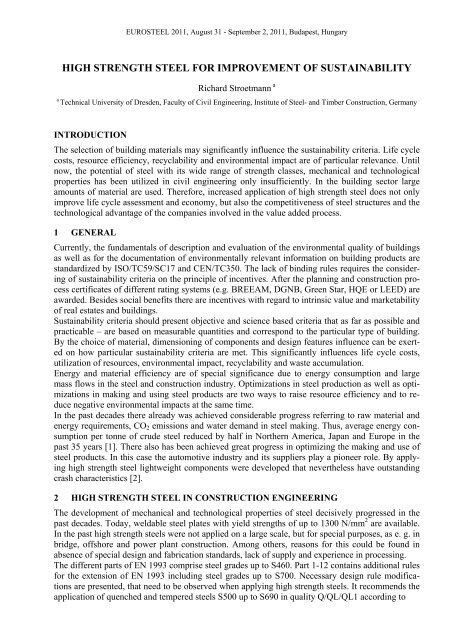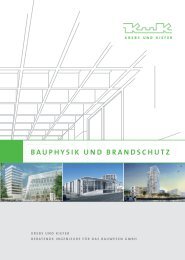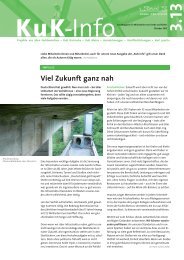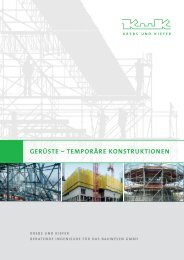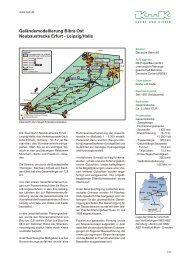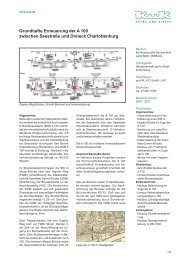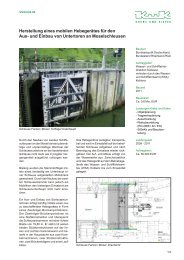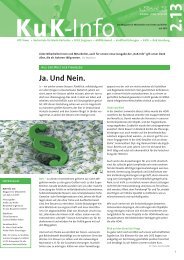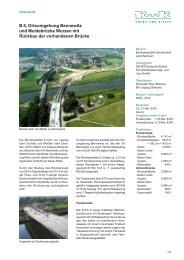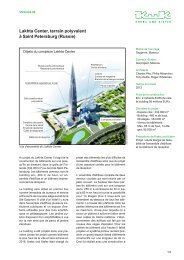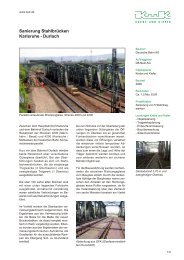HIGH STRENGTH STEEL FOR IMPROVEMENT OF SUSTAINABILITY
HIGH STRENGTH STEEL FOR IMPROVEMENT OF SUSTAINABILITY
HIGH STRENGTH STEEL FOR IMPROVEMENT OF SUSTAINABILITY
Create successful ePaper yourself
Turn your PDF publications into a flip-book with our unique Google optimized e-Paper software.
EURO<strong>STEEL</strong> 2011, August 31 - September 2, 2011, Budapest, Hungary<br />
<strong>HIGH</strong> <strong>STRENGTH</strong> <strong>STEEL</strong> <strong>FOR</strong> <strong>IMPROVEMENT</strong> <strong>OF</strong> <strong>SUSTAINABILITY</strong><br />
Richard Stroetmann a<br />
a Technical University of Dresden, Faculty of Civil Engineering, Institute of Steel- and Timber Construction, Germany<br />
INTRODUCTION<br />
The selection of building materials may significantly influence the sustainability criteria. Life cycle<br />
costs, resource efficiency, recyclability and environmental impact are of particular relevance. Until<br />
now, the potential of steel with its wide range of strength classes, mechanical and technological<br />
properties has been utilized in civil engineering only insufficiently. In the building sector large<br />
amounts of material are used. Therefore, increased application of high strength steel does not only<br />
improve life cycle assessment and economy, but also the competitiveness of steel structures and the<br />
technological advantage of the companies involved in the value added process.<br />
1 GENERAL<br />
Currently, the fundamentals of description and evaluation of the environmental quality of buildings<br />
as well as for the documentation of environmentally relevant information on building products are<br />
standardized by ISO/TC59/SC17 and CEN/TC350. The lack of binding rules requires the considering<br />
of sustainability criteria on the principle of incentives. After the planning and construction process<br />
certificates of different rating systems (e.g. BREEAM, DGNB, Green Star, HQE or LEED) are<br />
awarded. Besides social benefits there are incentives with regard to intrinsic value and marketability<br />
of real estates and buildings.<br />
Sustainability criteria should present objective and science based criteria that as far as possible and<br />
practicable – are based on measurable quantities and correspond to the particular type of building.<br />
By the choice of material, dimensioning of components and design features influence can be exerted<br />
on how particular sustainability criteria are met. This significantly influences life cycle costs,<br />
utilization of resources, environmental impact, recyclability and waste accumulation.<br />
Energy and material efficiency are of special significance due to energy consumption and large<br />
mass flows in the steel and construction industry. Optimizations in steel production as well as optimizations<br />
in making and using steel products are two ways to raise resource efficiency and to reduce<br />
negative environmental impacts at the same time.<br />
In the past decades there already was achieved considerable progress referring to raw material and<br />
energy requirements, CO2 emissions and water demand in steel making. Thus, average energy consumption<br />
per tonne of crude steel reduced by half in Northern America, Japan and Europe in the<br />
past 35 years [1]. There also has been achieved great progress in optimizing the making and use of<br />
steel products. In this case the automotive industry and its suppliers play a pioneer role. By applying<br />
high strength steel lightweight components were developed that nevertheless have outstanding<br />
crash characteristics [2].<br />
2 <strong>HIGH</strong> <strong>STRENGTH</strong> <strong>STEEL</strong> IN CONSTRUCTION ENGINEERING<br />
The development of mechanical and technological properties of steel decisively progressed in the<br />
past decades. Today, weldable steel plates with yield strengths of up to 1300 N/mm 2 are available.<br />
In the past high strength steels were not applied on a large scale, but for special purposes, as e. g. in<br />
bridge, offshore and power plant construction. Among others, reasons for this could be found in<br />
absence of special design and fabrication standards, lack of supply and experience in processing.<br />
The different parts of EN 1993 comprise steel grades up to S460. Part 1-12 contains additional rules<br />
for the extension of EN 1993 including steel grades up to S700. Necessary design rule modifications<br />
are presented, that need to be observed when applying high strength steels. It recommends the<br />
application of quenched and tempered steels S500 up to S690 in quality Q/QL/QL1 according to
Fig. 1. Schema for the production of heavy plates<br />
EN 10025-6 as well as thermomechanically rolled steel for cold forming S500 MC to S700MC according<br />
to EN 10149-2. Further recommendations are regulated in specific National Annexes by the<br />
states participating in the Eurocode programme.<br />
By various production processes (Fig. 1) high yield strengths can be generated if the steel is of suitable<br />
chemical composition. Besides heat treatment by normalizing, normalized rolling, hardening<br />
and tempering there were developed thermo-mechanical treatment processes that allow a reduction<br />
of alloying constituents by making use of micro-alloying elements, reducing the final rolling temperature<br />
down to the γ−α transformation range if applicable combined with differently accelerated<br />
cooling rates and self tempering. While having comparable strength properties these steels are easier<br />
to process and of higher toughness as compared to conventional production processes.<br />
3 LIFE CYCLE ASSESSMENT<br />
Life cycle assessment provides decision support to determine the further development of materials,<br />
products and buildings. ISO 14040 describes the principles and framework of life cycle assessment<br />
(LCA). ISO 14044 specifies requirements and provides guidelines for their implementation. LCA<br />
studies comprise four phases. The first phase defines the scope of the study including system<br />
boundaries and level of detail. The specifications depend on the object of investigation and the intended<br />
application of the study. The second phase is life cycle inventory (LCI) involving the determination<br />
of all input and output data with regard to the system under investigation. The third phase<br />
aims at impact assessment. Complementary to the life cycle inventory it provides additional information<br />
on assessment and evaluation of life cycle inventory results and their environmental relevance.<br />
Life cycle inventory data of the same environmental impact will be summarised to impact<br />
categories (Table 1, [3]). The last phase deals with the interpretation of results.<br />
The present database for environmental product declarations in the field of steel constructions is not<br />
satisfactory. It does not represent the variety of steel materials, heat treatment processes, shapings,<br />
surface coatings and possible combinations with other materials. Moreover, there is a lack of information<br />
on structural steel work, utilization phase and dismantling (Fig. 2, [4]).<br />
In general assessment of steel products is based on a crude steel mix of primary and secondary steel.<br />
In recent years there were applied the assessment methods cut-off, closed-loop and multi step approach<br />
as well as the approach of crude steel mix with credits. There are essential differences in<br />
estimating the proportion of scrap in crude steel production and recycling credits, taking into account<br />
product reuse as well as creation of additional scrap resources (avoidance of primary steel<br />
production [5], Fig. 3).
Table 1. Criteria for the assessment of the ecological quality and factors of importance (DGNB [3])<br />
category criterion factor of importance<br />
impacts on the<br />
global<br />
and local environment<br />
utilization of<br />
resources<br />
and waste<br />
accumulation<br />
Global warming potential (GWP) 3<br />
Ozone depletion potential (ODP) 0,5<br />
Photochemical ozone creation potential (POCP) 0,5<br />
Acidification potential (AP) 1<br />
Eutrophication potential (EP) 1<br />
Risks for the local environment 3<br />
Other impacts on the global environment 1<br />
Microclimate 0,5<br />
Non-renewable primary energy demand 3<br />
total primary energy demand and share of renewable primary energy 2<br />
Drinking water demand and volume of waste water space demand 2<br />
Land use 2<br />
a′ 1 -a′ n b′ 1 -b′ n c′ 1 -c′ n d′ 1 -d′ n e′ 1 -e′ n f′ 1 -f′ n g′ 1 -g′ n<br />
t′ 1 t′ 2 t′ 3 t′ 4<br />
t′ 5 t′ 6<br />
A B C D E F G<br />
raw material T1 steel making T2 products T3 shop<br />
T4 T5 T6 dismantling,<br />
extraction<br />
(sections, fabrication<br />
recycling<br />
plates etc.) (preservation)<br />
erection<br />
phase<br />
(assembling,<br />
preservation)<br />
utilization<br />
(inspection,<br />
maintenance,<br />
alteration)<br />
t1 t2 t3 t4 t5 t6 a 1 -a n b 1 -b n c 1 -c n d 1 -d n e 1 -e n f 1 -f n g 1 -g n<br />
A – G: primary process; a – g: auxiliary materials and energy input; a' – g': waste/ by-products and energy output;<br />
T 1–T 7: transports of primary process; t 1–t 7 and t' 1–t' 7: other transports<br />
[%]<br />
100<br />
80<br />
60<br />
40<br />
20<br />
0<br />
Fig. 2. Demand for information: module to describe the life cycle [4]<br />
CED GWP AP<br />
primary steel route (BF, B<strong>OF</strong>)<br />
secundary steel route (EAF)<br />
crude steel mix (70% BF/B<strong>OF</strong>, 30% EAF)<br />
closed-loop-approach<br />
Fig. 3. Comparison of ecological indicators [6]<br />
crude steel mix (70% BF/B<strong>OF</strong>, 30% EAF)<br />
with credits<br />
4 ENVIRONMENTAL IMPACT <strong>OF</strong> VARIOUS <strong>STEEL</strong>S<br />
Starting from identical assessment approaches for crude steel and identical dimensions after rolling,<br />
various steel grades mainly differs in their alloying constituents and heat treatment processes (Fig. 1<br />
and 4). As with quenched and tempered steels particularly alloying constituents such as molybdenum,<br />
chromium and silicon as well as heat treatment essentially influence life cycle assessment.<br />
t′ 7<br />
t 7
The gain in strength due to the application of micro-alloying elements in combination with thermomechanical<br />
rolling offers great advantages (Fig. 4, [6]).<br />
Fig. 5 shows the relation of CED, GWP100 and AP for heavy plates made of various steel grades<br />
compared to the expenses for a S235J2. Based on these indicators and in combination with the factors<br />
of importance, listed in Table 1, an estimation of the environmental impact determines necessary<br />
savings of 3.3 to 17.1 % of steel consumption as compared to the application of S235J2 (Table<br />
2, [6]).<br />
Table 2. required weight saving ΔG in [%] compared to steel grade S235J2 [6]<br />
S355J2 S420N S460N S420M S460M S460Q S500Q S550Q S620Q S690Q<br />
heavy plates 6,6 9,3 10,6 3,3 4,1 10,2 11,1 13,4 15,5 17,1<br />
rolled sections 6,7 8,8 9,9 3,4 4,2 10,0 10,7 12,6 14,2 15,6<br />
Fig. 4. Cumulated energy demand (CED) for heavy plates (closed-loop-approach)<br />
made of various steel grades [6]<br />
Fig. 5. Relation of CED, GWP100 and AP of heavy plates<br />
for various steel grades referring to S235J2 [6]<br />
5 EFFECTIVE APPLICATION <strong>OF</strong> <strong>HIGH</strong>ER <strong>STRENGTH</strong>S <strong>STEEL</strong><br />
The application of higher strength steels is advantageous when an increase in strength enables a<br />
reduction of steel consumption. This will not only improve life cycle assessment but also the economic<br />
efficiency of constructions. Fig. 6 shows a relative price comparison for heavy plates of various<br />
steel grades. The comparison bases on average prices provided by different producers in the<br />
German market [6]. Compared to the increase in strength there is only a moderate increase in price<br />
that may be compensated by appropriate weight savings.
Fig. 6. Economic efficiency of heavy plates, if only the material price is taken into account<br />
Fig. 7. Dimensioning of tension bars with different steel grades and corresponding but welds<br />
Mass reduction requires that the resistance of a structural element will not be dominated by buckling<br />
or fatigue resistance. Furthermore, criteria of serviceability – such as limits for deflections and<br />
for dynamic effects (e.g. minimal vibration frequency) – should not determine the dimensions.<br />
The required dimensions of a tension bar are significantly affected by material strength. The crosssectional<br />
areas can be reduced reciprocally in proportion to yield strength. For butt welds with a<br />
constant included angle the weld volume increases with the square of the plate thickness. For this<br />
reason reduction of plate thickness has positive effects on welding production. (Fig. 7).<br />
High strengths positively influence steel consumption, if stability sensitive members are in a range<br />
of compact and medium slenderness. Fig. 8 shows the buckling resistance of a columns made of a<br />
hollow section (SHS 300x16) for different buckling lengths and steel grades. It shows that the differences<br />
decrease, when the buckling length increases. In conventional storey buildings with buckling<br />
lengths of columns between 3 and 5 m, the high strengths have a very positive impact on resistance.<br />
The reverse conclusion is, that smaller cross-sections may used for the same requirements<br />
of resistance.<br />
For structures, where the weight has a significant influence on the structural design, mass reduction<br />
has a double positive effect: The action effects of the elements are reduced and thus further savings<br />
of materials are possible. Examples are large-span structures, such as bridges; exhibition, storage<br />
and production halls as well as stadium roofs.<br />
The application of higher steel strength may also improve functional aspects. In story buildings<br />
long-span beams allowed a reduction of columns and walls and thus a flexible floor plan design.<br />
The storey height and thus the building volume to be heated can be reduced by beams with lower<br />
height. Columns reduce the rentable space of buildings and leads to restrictions in utilization. Especially<br />
in storey buildings with high column loads the cross sections may reduce by application of<br />
high strength steels.
uckling resistance N b,Rd [kN]<br />
14000<br />
12000<br />
10000<br />
8000<br />
6000<br />
4000<br />
2000<br />
S 690 typical range for the<br />
buckling length of columns<br />
in storey-buildings<br />
S 460<br />
S 420<br />
S 355<br />
S 235<br />
0<br />
0 1 2 3 4 5 6 7 8 9 10 11 12 13 14 15<br />
buckling length L cr [m]<br />
Fig. 8. Design resistance of columns made of hollow sections for different steel grades<br />
F Ed<br />
L cr<br />
SHS<br />
300x16<br />
6 ACKNOWLEDGMENT<br />
High strength steels will become more and more relevance in building construction. Due to the enlargement<br />
and adaption of technical rules, such as Eurocode 3, material standards and manufacturing<br />
guidelines, this trend will be supported. Technical assistance for planning and execution as well<br />
as better availability of sections and plates out of high straight steels are important for the transfer to<br />
the construction industry. In the end, it is a matter of competitiveness in the national and international<br />
market, in which steel producers and processors, manufacturers and developers of construction<br />
products, planning engineers as well as the processing steel construction companies are involved.<br />
REFERENCES<br />
[1] Ameling, D, Endemann, G, “Ressourceneffizienz: Gute Argumente für den Stahl”, Stahl und Eisen 127,<br />
Heft Nr. 8, Verlag Stahleisen GmbH, Düsseldorf, 2009.<br />
[2] Hoffmann, O, “Karosserie-Leichtbau in Stahl als Beitrag zur Energieeinsparung”, Deutsches Klimaforschungsprogramm<br />
(DEKLIM), Abschlusssymposium. Bonn, April 2005.<br />
[3] “Das Deutsche Gütesiegel für nachhaltiges Bauen – Aufbau, Anwendung, Kriterien”, Deutsche Gesellschaft<br />
für nachhaltiges Bauen, 2. Auflage, März 2009.<br />
[4] Stroetmann, R, Deepe, P, “Anwendung höherfester Stähle zur Steigerung der Ressourceneffizienz im<br />
Bauwesen”, VDI-Berichte 2084 - Bauen mit innovativen Werkstoffen, pp. 267 – 305, Köln, November<br />
2009.<br />
[5] bauforumstahl „Umweltproduktdeklaration für Baustähle - Offene Walzprofile und Grobbleche“ (EPD-<br />
BFS-2010111-D), Düsseldorf, November 2010.<br />
[6] Stroetmann, R, “Nachhaltigkeit und ressourceneffizienter Einsatz höherfester Stähle“, iforum Nachhaltigkeit<br />
an der TU Dresden, Dresden, Oktober 2010.


